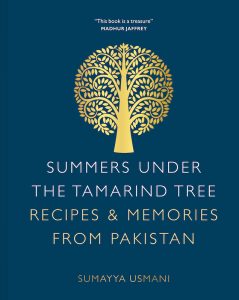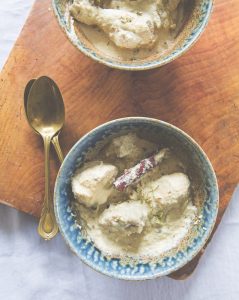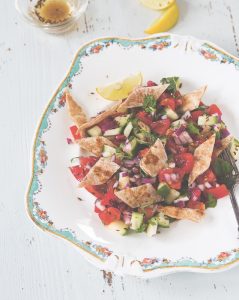I know that summer is now just a memory, but I wanted to share with you a fabulous cookbook that is so evocative that you can almost smell those exciting scents and hear the sounds of author Sumayya Usmani’s childhood in Pakistan.
 In this new edition of her award-winning memoir-cookbook, Summers Under The Tamarind Tree she celebrates the varied, exciting and oft-overlooked cuisine of her beautiful birthplace, honouring its heritage and traditions through more than 100 family recipes and evocative food memories.
In this new edition of her award-winning memoir-cookbook, Summers Under The Tamarind Tree she celebrates the varied, exciting and oft-overlooked cuisine of her beautiful birthplace, honouring its heritage and traditions through more than 100 family recipes and evocative food memories.
“When people think of Pakistan, they probably picture a simple land plagued by troubles.” She says, “But having grown up in Karachi, my memories of my childhood in Pakistan are filled with exciting scents, sounds and rich flavours. Food is the spirit of Pakistani people and the cuisine has been hundreds of years in the making. When I moved to the UK, I was struck by the fact that despite a large Pakistani diaspora, our cuisine never found its individual voice.
“My patriotic spirit and passion for the food I grew up cooking and eating sowed the seeds for this book. I hope that the flavour of my heritage comes through in each recipe I share.”
With food photography by Joanna Yee and published by White Lion Publishing at £20 SUMMERS UNDER THE TAMARIND TREE: Recipes & Memories from Pakistan is a fabulous book.
Here are a few of its recipes to whet your appetite.
White chicken korma with almond and pistachio
Preparation 15 minutes | Cooking 45–55 minutes | Serves 6–8
“Most kormas in Pakistan are a rich reddish colour; however, this recipe of my mother’s is a creamy white nutty version. This is not because of any addition of cream (using cream in kormas is uncommon in Pakistan), but because of the yogurt. Dried methi leaves added at the end gives the dish an unusual scent that’s as intoxicating as it is haunting.”
115g/4oz/¾ cup blanched almonds
3 tbsp ghee
3 tbsp vegetable oil
1 cinnamon stick
5 green cardamom pods, crushed
2 large red onions, very finely chopped
1 tsp each of grated ginger and crushed garlic
4–5 tbsp vegetable or sunflower oil
1 kg/2¼ lb chicken, skinned and cut into 14 pieces
350ml/12 fl oz/1½ cups plain yogurt
2–3 dried long red chillies
salt, to taste
2 tbsp ground pistachios
½ tbsp dried methi (fenugreek) leaves
Method:
Put the almonds in a bowl of water and leave to soak. Heat the ghee and oil in a saucepan over a medium heat. Add the cinnamon and cardamon.
When they splutter, add the onions and sauté for 5–6 minutes until soft. It is very important that the onions don’t change colour at all, but are just allowed to get slightly translucent.
Add the ginger and garlic and stir-fry until the raw smell of garlic disappears. Do not let the mixture brown.
Heat some oil in a separate pan. When hot, add the chicken pieces and fry until they are a golden colour all over. Add the chicken to the onion mixture and continue to cook. At this
point add the yogurt and bhuno (stir-fry) for a bit. Add the red chillies but make sure they don’t break up, as it is vital that the korma does not get coloured by the chillies. I usually
remove the seeds and add them later. Add salt to taste.
Meanwhile, blend the almonds with their soaking water to a smooth paste, then add to the pan together with the pistachios. Cover the pan with foil firmly around the edges,
cover with the lid, reduce the heat to medium-low, and let it cook in its own steam.
Keep checking on the korma. The end result should be a thick gravy. If it is watery, uncover, increase the heat to high heat and cook until the korma gravy is thick.
When the chicken is cooked and the gravy is ready, crush the dried methi between your hands and sprinkle over the top.
Crispy chapati kachumber salad – Preparation 20 minutes | Serves 4–6
“This popular South Asian salad is made from uniformly diced pieces of fresh vegetables, lots of lemon and dry-roasted cumin.
It’s a great accompaniment to barbecue dishes and biryanis. Inspired by Italian panzanella, I’ve added crispy leftover chapati (or use paratha) for texture.”
2 large tomatoes, deseeded and finely chopped
1 large red onion, finely chopped
1 cucumber, deseeded and finely chopped
1–2 thin green chillies, deseeded and finely chopped
2 tbsp fresh pomegranate seeds
juice of 1 lemon, plus wedges to garnish
salt, to taste
1 tsp dry-roasted cumin seeds, roughly ground
½ tsp chaat masala
1 chapati bread, toasted and broken into small 2.5cm/1-inch pieces
Method:
Combine the first five ingredients with the lemon juice, cumin, salt and chaat masala.
Chill until serving. Add the broken chapati pieces before serving and stir well. Garnish with lemon wedges.
Walnut and cardamom ladoo Preparation 15 minutes | Cooking 15 minutes | Serves 6–8
“Walnuts grow in abundance in northern Pakistan, and this is a traditional dessert making use of the bounty.”
2 tbsp ghee 
3 green cardamom pods, seeds finely ground
250g/9oz/2½ cups shelled walnuts, finely ground
150–200ml/5–7 fl oz/2⁄3–scant 1 cup condensed milk
3 tbsp desiccated (dry unsweetened) coconut
Method:
Heat the ghee in a heavy-based saucepan over a medium heat. When hot, add the ground cardamom and stir for 2–3 minutes until the ghee is fragrant.
Add the ground walnuts and stir for about 2 minutes until the walnuts smell slightly roasted.
Pour in the condensed milk and stir vigorously for about 10 minutes or so, or until the mixture comes together like a ball.
Once you reach this stage, turn off the heat and allow the walnut mixture to cool for about 3–4 minutes. Spread the desiccated coconut out on a plate.
Using your hands, form about 1 tablespoon of the mixture into golf ball-sized balls then roll in the desiccated coconut. Place on a plate and allow to cool completely. Cover and store in a cool, dry place and eat within 3–4 days.




